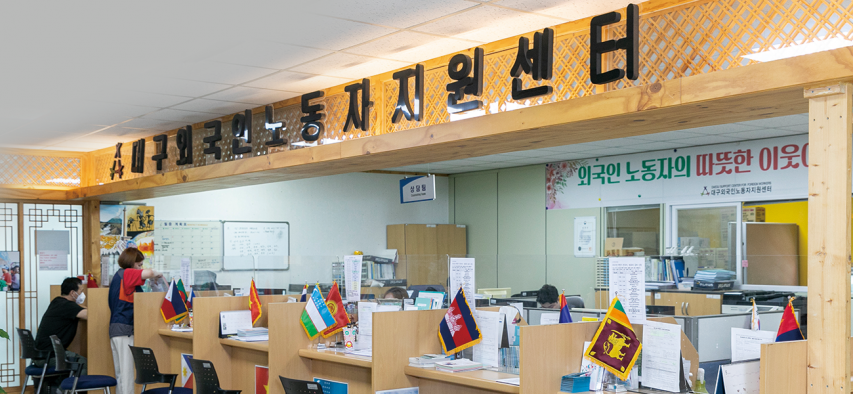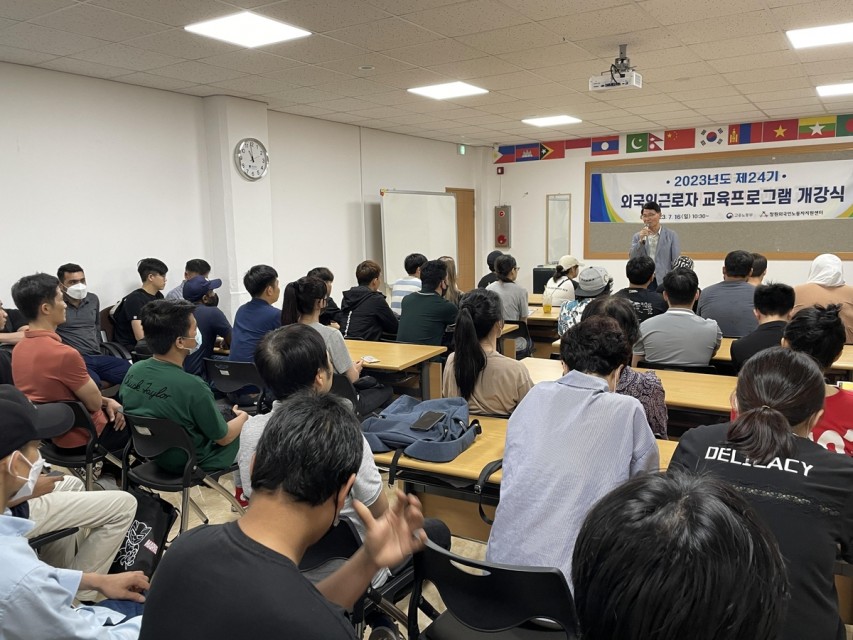[Feature] Who Supports the Migrant Workers We Rely On?
Migrant workers are no longer optional in South Korea—they are essential. As of 2024, over 2.65 million foreigners live in the country, comprising more than 5% of the population. Many fill labor shortages, especially in depopulated rural areas. In response, the government expanded the E-9 visa for low-skilled foreign workers to a record quota of 165,000 in 2024.
Yet this growth contrasts with declining support. The clearest example is major budget cuts to foreign worker support centers. While migrant numbers rise, key support systems are being dismantled.
Migrant Labor Rises, Government Support Falls
As Korea faces a declining birthrate, an aging population, and growing reluctance among youth to take certain jobs, reliance on migrant labor keeps rising. In many industries, migrant workers have become indispensable—especially in rural communities struggling to maintain their workforce.
Jeon Eon-jun, owner of an inland fish farm in Gwangju, employs eight Sri Lankan workers—90% of his foreign staff—following the 2023 employment quota expansion. “They support an industry most Koreans avoid and ensure stable, quality food production,” he said. Having worked closely with migrant laborers, he stressed the need for better protections: “They are vital to our economy. Their legal status and working conditions must be clearer so they can access rights and benefits.”
Despite the workforce expansion, the Ministry of Employment and Labor announced in September 2023 that it would cut the entire 7.18 billion won budget for foreign worker support centers, which had offered counseling, education, and welfare aid. This led to the closure of 9 national centers and 35 local offices.
Since 2004, these centers had operated under a public-private model based on accumulated expertise. But the Ministry replaced them with a centralized, government-run system via local offices and Human Resources Development Service of Korea (HRDK). Critics warned of lost know-how and reduced effectiveness. Although 1.8 billion won was partially restored, only nine municipalities were chosen for a pilot program—each capped at 200 million won, a steep downgrade from past funding.

Foreign worker support centers
Photo: Wolgan Naeil (labor21.kr)
Disrupted Services, Unready Replacements
Although funding was slashed, the workload at foreign worker support centers has remained the same—or grown. With fewer staffs and greater responsibilities, many centers are struggling to find alternative funding. The Ministry of Employment and Labor claimed it would shift multilingual counseling to local offices and transfer training to HRDK, but this restructuring has created service gaps, especially in interpretation and counseling.
Centers previously offered specialized services such as labor counseling, Korean language education, and employment permit guidance. But with staff reduced by four to ten people per center, employees are overworked. Resident interpreters are rare, and daily interpreters are only available for limited hours—leaving many workers without native-language support. Duties are no longer divided, placing all operations on a few remaining staff. In some cases, directors have taken on part-time jobs to cover deficits.
The Ministry of Employment and Labor announced that it plans to operate nine support centers with local governments to provide various residency support services tailored to local characteristics and will also provide direct counseling and Korean language training services starting in 2024. However, recruitment of multilingual counselors was halted due to a lack of applicants, and HRDK was only able to hire seven new staffs. While 41 vocational training centers now teach Korean to foreign workers, most lack relevant experience.
In a national audit of labor ministry agencies on October 22, 2024, Park Jung, a member of The National Assembly and the Environment and Labor Committee pointed out that the situation was worse than when privately outsourced. Poor preparation and lack of research were cited as core problems. In response, local governments and private groups have stepped in to fill the gaps.
Joo Jin-woo, director of Pool-bbang Workers Mutual, called for a national debate on how migrant labor should be introduced. Based on Seoul’s domestic worker pilot program, he emphasized the need to rethink which sectors should employ migrant labor. Communication barriers, cultural differences, and everyday hardships—once addressed by support centers—remain pressing concerns.
Education program opening ceremony
Photo: Yonhap News (yna.co.kr)
What Do Migrant Workers Mean to Us?
When asked about migrant workers’ role in Korean society, Joo emphasized they have supported the economy for over 30 years, since the launch of the Foreign Industrial Trainee Program in 1993. This system allowed foreigners to become full-time workers after training and verification period. To address labor shortages, the government has introduced foreign workers for limited periods in targeted sectors. Migrant workers are now vital in small and medium-sized manufacturing, agriculture, and fishery.
Joo noted that public attitudes have grown more inclusive, aided by migrants’ visibility and growing awareness of global citizenship. However, with the foreign worker population exceeding one million, social backlash and xenophobia have also increased.
“Support measures are urgently needed to help migrant workers feel secure and integrated, so they can contribute fully to the economy,” he said. “We must address discrimination and discomfort to prevent future conflict and foster a welcoming attitude.”
He added that young Koreans will increasingly live and work alongside migrants. “Caring about their working conditions and rights as fellow members of society—not just as outsiders—enhances our collective quality of life. Solidarity with those in vulnerable conditions is key to building an inclusive society.”
South Korea is now home to over three million migrants. Though not always reflected in demographic statistics, migrant workers are vital to industries such as manufacturing, agriculture, construction, fishery, and service sector. They support small and medium-sized businesses facing labor shortages and contribute to the local economy through diverse patterns of consumption.
As their numbers grow, so do the challenges. Experts call for greater attention to the regressive trends surrounding migrant rights and support. For younger generations, including university students, recognizing that migrants are no longer outsiders—but part of our shared social fabric—is a necessary step toward a more inclusive society.
There are no registered comments.
I agree to the collection of personal information. [view]


